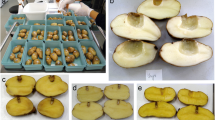Summary
Crosses were made between six parents differing in susceptibility to skin spot and glasshouse-grown tubers from true seedlings of the nine resulting progenies assessed for resistance to the disease. The assessment was evaluated by a two-year comparison with the behaviour of field-grown tubers of the progenies and their parents. The correlations between progenies in the glasshouse and field were r=0.911 and 0.753 and those between the mid-parental values and the progeny means were high (r>0.864), indicating that parental differences were heritable. It is concluded that correlations were sufficient for glasshouse-grown tubers to be used for assessing large numbers of progenies in genetical studies and for eliminating highly susceptible progenies at an early stage in a breeding programme.
Similar content being viewed by others
References
Anonymous, 1976. Potato skin spot. Agricultural Development and Advisory Service Key No. 2.2.1. Pinner, Middlesex, Ministry of Agriculture, Fisheries and Food.
Carnegie, S.F., 1988.Polyscytalum pustulans (Owen & Wakef.) M.B. Ellis. In: I.M. Smith, J. Dunez, D.H. Phillips, R.A. Lelliott & S.A. Archer (Eds). European handbook of plant diseases. Blackwell Scientific Publications. Oxford, UK. pp. 408–409.
Carnegie, S.F. & A.M. Cameron, 1983. Testing potato cultivars for susceptibility to skin spot (Polyscytalum pustulans).Potato Research 26: 69–72.
Carnegie, S.F. & A.M. Cameron, 1992. Resistance to thiabendazole in isolates ofPolyscytalum pustulans (skin spot) andFusarium solani var.coeruleum (dry rot) in Scotland.Plant Pathology 41: 606–610.
Hide, G.A., 1981. Skin spot. In: W.J. Hooker (Ed.), Compendium of potato diseases. American Phytopathological Society, St. Paul. Minn. USA, pp. 37–38.
Hide, G.A. & G.R. Cayley, 1987. Effects of delaying fungicide treatment and of curing and chlorpropham on the incidence of skin spot on stored potato tubers.Annals of Applied Biology 110: 617–627.
Nagdy, G.A. & A.E.W. Boyd, 1965. Susceptibility of potato varieties to skin spot (Oospora pustulans) in relation to the structure of the skin and eye.European Potato Journal 8: 200–214.
Wastie, R.L., J.E. Bradshaw, M.F.B. Dale, G.R. Mackay, M.S. Phillips & R.M. Solomon-Blackburn, 1991. Progeny testing for resistance to dieases and pests of potatoes. Annual Report of the Scottish Crop Research Institute for 1991. Scottish Crop Research Institute. Dundee, pp. 13–16.
Author information
Authors and Affiliations
Additional information
R.L. Wastie died 16.01.96.
Rights and permissions
About this article
Cite this article
Wastie, R.L., Stewart, H.E., Bradshaw, J.E. et al. Assessing progenies of potato for resistance to skin spot (Polyscytalum pustulans) in the glasshouse. Potato Res 40, 383–389 (1997). https://doi.org/10.1007/BF02357997
Accepted:
Issue Date:
DOI: https://doi.org/10.1007/BF02357997




